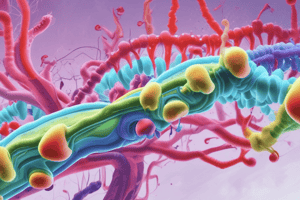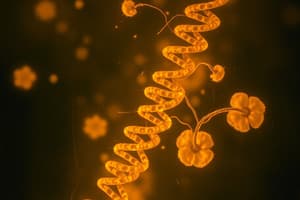Podcast
Questions and Answers
What was the unexpected outcome of Rich Jorgensen's experiment with petunias?
What was the unexpected outcome of Rich Jorgensen's experiment with petunias?
- The flowers bloomed earlier than usual
- The petunias produced more seeds than expected
- The flowers turned a different shade of purple
- The flowers turned white instead of purple (correct)
What role does RNA interference (RNAi) play in cellular defense?
What role does RNA interference (RNAi) play in cellular defense?
- It enhances the replication of viral RNA
- It identifies and destroys suspicious RNA shapes (correct)
- It prevents gene expression during cell division
- It increases the rate of protein synthesis
Which disease condition has shown potential for treatment with RNA interference?
Which disease condition has shown potential for treatment with RNA interference?
- Tuberculosis
- Chickenpox
- Macular degeneration (correct)
- Influenza
What mechanism does RNA interference utilize to target harmful RNA?
What mechanism does RNA interference utilize to target harmful RNA?
How does RNAi enhance our understanding of gene function?
How does RNAi enhance our understanding of gene function?
What is the primary implication of RNA's role in biology?
What is the primary implication of RNA's role in biology?
What common misconception might exist regarding the function of RNA in cellular protection?
What common misconception might exist regarding the function of RNA in cellular protection?
What potential future applications does RNA interference (RNAi) hold?
What potential future applications does RNA interference (RNAi) hold?
What happens to the lac operon when lactose is present?
What happens to the lac operon when lactose is present?
Which of the following is a function of transcription factors in eukaryotes?
Which of the following is a function of transcription factors in eukaryotes?
What is the primary role of HOX genes during development?
What is the primary role of HOX genes during development?
Which mechanism does NOT describe how eukaryotic gene regulation can occur?
Which mechanism does NOT describe how eukaryotic gene regulation can occur?
How do methyl groups function in gene expression?
How do methyl groups function in gene expression?
What is a distinguishing feature of RNA interference (RNAi)?
What is a distinguishing feature of RNA interference (RNAi)?
Which statement about epigenetics is true?
Which statement about epigenetics is true?
What is the primary function of alternative RNA splicing?
What is the primary function of alternative RNA splicing?
Which type of gene regulation involves managing the timing of gene expression?
Which type of gene regulation involves managing the timing of gene expression?
How do enhancers contribute to transcription?
How do enhancers contribute to transcription?
What is one consequence of abnormal gene expression regulation?
What is one consequence of abnormal gene expression regulation?
What role do small RNA molecules play in gene expression?
What role do small RNA molecules play in gene expression?
Which of the following is true about the lac operon in E.coli in the absence of lactose?
Which of the following is true about the lac operon in E.coli in the absence of lactose?
How do environmental factors impact epigenomes?
How do environmental factors impact epigenomes?
What is the primary function of microRNAs (miRNAs) in gene regulation?
What is the primary function of microRNAs (miRNAs) in gene regulation?
Which of the following accurately describes the role of RNA polymerase in transcription?
Which of the following accurately describes the role of RNA polymerase in transcription?
In which stage of cell division do sister chromatids separate?
In which stage of cell division do sister chromatids separate?
What occurs during the G1 phase of interphase?
What occurs during the G1 phase of interphase?
What defines a haploid cell?
What defines a haploid cell?
What is the purpose of the GTP cap on the 5' end of an mRNA molecule?
What is the purpose of the GTP cap on the 5' end of an mRNA molecule?
Which type of DNA repair involves the removal and replacement of damaged bases?
Which type of DNA repair involves the removal and replacement of damaged bases?
What is a characteristic feature of chromosomes during cell division?
What is a characteristic feature of chromosomes during cell division?
How do mutations typically affect the amino acid sequence of proteins?
How do mutations typically affect the amino acid sequence of proteins?
What is the primary outcome of meiosis?
What is the primary outcome of meiosis?
Which type of operon is exemplified by the regulation of genes involved in tryptophan synthesis?
Which type of operon is exemplified by the regulation of genes involved in tryptophan synthesis?
What is the main function of tRNA in translation?
What is the main function of tRNA in translation?
What do histones contribute to the organization of DNA?
What do histones contribute to the organization of DNA?
What is the significance of crossing over during meiosis?
What is the significance of crossing over during meiosis?
Flashcards are hidden until you start studying
Study Notes
The Lac Operon
- Discovered by Jacob and Monod in 1961.
- Regulates the production of enzymes needed to break down lactose.
- Operon is active when lactose is present, inactive when lactose is absent.
- Repressor protein binds to the operator, blocking RNA polymerase transcription when lactose is absent.
- Lactose binding to the repressor causes a conformational change, preventing it from binding to the operator and allowing transcription.
- Three enzymes are regulated as a single unit: LacZ (β-galactosidase), LacY (Galactose permease), LacA (Thiogalactoside transacetylase).
Gene Regulation in Eukaryotes
- Different cell types have different sets of genes expressed, despite having the same complete set (~37 trillion cells).
- Various mechanisms control gene expression, including DNA packing, transcription factors (TFs), alternative RNA splicing, microRNAs, and translation regulation.
Eukaryotic Transcription Complexes
- TFs are essential for gene expression timing, and 10% of the human genome functions as TFs.
- Enhancers are DNA sequences where TFs bind.
- TFs assist RNA polymerase in binding to the promoter to initiate transcription.
- Homeodomain proteins, coded by HOX genes, are crucial TFs in development.
Homeobox (HOX) Genes
- Regulate body plan along the "head-tail" axis.
- Essential for proper development in all organisms.
- For example, the HOX gene Ubx affects wing development, and turning it off causes a second pair of wings.
HOX Genes and Development
- Expressed in specific body regions during embryological development.
- Highly conserved across species, controlling body regions consistently.
- Contribute to the evolution of body plans during the Cambrian explosion.
Epigenetics
- The study of heritable changes in gene expression without DNA sequence alterations.
- Changes phenotype but not genotype.
- Environmental factors (diet) can change epigenomes.
- Epigenetic control involves methyl groups, acetyl groups, and small RNA molecules which can activate or repress genes.
RNA Interference (RNAi)
- RNA molecules suppress gene expression by destroying mRNA or blocking translation.
- Discovered by Craig Mello and Andrew Fire, who won the Nobel Prize in 2006.
- Used as a therapeutic tool to treat various diseases by silencing malfunctioning genes.
- RNAi enables researchers to deactivate specific genes and understand their functions.
Role of MicroRNAs (miRNA)
- Major role in regulating gene expression.
- siRNA (small interfering RNA) silences specific genes, while miRNA can silence multiple genes.
Transcription
- RNA polymerase unwinds DNA, binds to the promoter, and adds complementary base pairs to the template strand, creating mRNA.
- Template strand (antisense) is complementary to the mRNA strand, with thymine (T) replaced with uracil (U).
Post-Transcription
- Introns (non-coding regions) are removed via spliceosomes, leaving exons (coding regions).
- mRNA is capped with GTP at the 5' end and a poly-adenine tail at the 3' end, protecting it from degredation and signaling nuclear export.
Mutations: Damage and Repair
- Mutations can be caused by replication errors or mutagens.
- Mismatch repair uses DNA polymerase and other proteins to correct mismatched bases during replication.
- Base excision repair and nucleotide excision repair remove damaged bases.
- Homologous recombination and non-homologous end joining repair broken DNA strands.
Cell Division
- Karyotype: normal number of chromosomes in the nucleus of eukaryotic cells, consisting of 23 pairs – 22 pairs of autosomal chromosomes and 1 pair of sex chromosomes.
- Diploid cells contain two sets of chromosomes (46), while haploid cells contain one set (23).
Mitosis
- Occurs in somatic cells and involves replicating the full diploid chromosome complement.
- Stages:
- Interphase: G1 (growth), S (DNA replication), G2 (growth and organelle replication).
- Prophase: Chromosomes become visible, centrioles move to opposite poles.
- Metaphase: Chromosomes line up at the center, spindle fibers attach to centromeres.
- Anaphase: Sister chromatids separate.
- Telophase: Chromosomes gather at opposite ends, lose rod shape, two nuclear membranes form.
- Cytokinesis: Cell membrane pinches, divides in half, forming two new identical cells.
Meiosis
- Occurs in sex organs to produce haploid germ cells (sperm/egg).
- Stages:
- Interphase: chromosomes duplicate.
- Meiosis I:
- Prophase: chromosomes pair up, crossing over.
- Metaphase: chromosomes line up in pairs.
- Anaphase: chromosomes separate.
- Telophase and Cytokinesis: two non-identical diploid cells are formed.
- Meiosis II:
- Prophase, Metaphase, Anaphase, Telophase, and Cytokinesis: four non-identical haploid cells are formed.
Cancer
- Characterised by unchecked growth and division due to disrupted interphase checkpoints.
- Chemotherapy can interfere with cell division and replication, but can also damage normal cells.
Gene Regulation
- Controlling which genes are "on" or "off" for protein production.
- Operons are a mechanism of gene regulation in prokaryotes.
- Lac operon example:
- Repressor binds to the operator, preventing transcription when lactose is absent.
- Lactose binding to the repressor inactivates it, allowing transcription.
Prokaryotic Transcriptional Regulation
- Ability to change metabolic activities in response to the environment.
- Inducible control (Lac operon): repressor is inactivated by inducer.
- Repressible control (Trp operon): repressor is activated by the product.
DNA Structure and Function
- DNA: Deoxyribose Nucleic Acid. Carries genetic information in genes.
- RNA: ribonucleic acid. Copies of DNA for protein synthesis.
- DNA structure: double helix, sugar-phosphate backbone, with purines (adenine, guanine) pairing with pyrimidines (cytosine, thymine) via hydrogen bonds.
DNA Replication
- 5' to 3' direction.
- Helicase unwinds the DNA strands.
- Single-strand binding proteins keep the strands separated.
- Primase adds RNA primers.
- DNA polymerase adds complementary nucleotides to the 3' end, leading to elongation.
- Okazaki fragments are formed on the lagging strand, joined by ligase.
Packaging DNA
- Histones are proteins around which DNA is wrapped and is the first step in DNA packaging, forming a "beads on string" structure.
- Nucleosomes are more tightly wound histones and DNA.
- Chromatin is tightly wound nucleosomes forming a fiber.
- Chromosomes are supercoiled chromatin that only forms when cells are dividing.
Translation
- mRNA carries information to ribosomes where translation into proteins takes place.
- tRNA carries specific amino acids to the ribosome, guided by codons on the mRNA.
Central Dogma
- Proposed by Francis Crick.
- The flow of genetic information from DNA to mRNA to protein.
Genetic Code
- Information encoded in nucleotide base sequences of DNA.
- Translated into amino acids by codons (groups of three nucleotides).
- Amino acids form proteins in ribosomes.
Genes and Genetic Variation
- Genes are functional and physical units of heredity on chromosomes.
- Mutations are changes in the nucleotide sequences, which can be substitutions, insertions, or deletions.
Studying That Suits You
Use AI to generate personalized quizzes and flashcards to suit your learning preferences.




